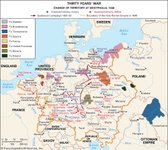Thirty Years’ War | Summary, Causes, Combatants, Map, & Significance | Britannica
britannica.com
Thirty Years’ War | Summary, Causes, Combatants, Map, & Significance | Britannica

Thus much of the intellectual and political energy of sixteenth-century Europe was consumed by the religious and dynastic warfare that racked the continent until the peace of exhaustion at the end of the century. Set against this background, it is easy to see why European expansion was a meagre threat to the Islamic empires or the great states in
... See moreBut the crucial fact of the equilibrium age was that no power in Europe was strong enough to dominate the others completely, or to embark upon a career of overseas conquest safe from the challenge of its European rivals.
Europe was almost always a loose-knit ‘confederation’ of culturally similar states in whose mutual relations economic strength was only one of several important variables. Religious affiliation, dynastic allegiance, ideology and ethnic cohesion interacted unpredictably with economic forces to ensure the survival of some political and cultural units
... See moreFar from imagining a common supremacy over the rest of Eurasia, European statecraft was obsessed with intramural conflicts. Symptomatically, the wealth of the New World was used to finance the dynastic ambitions of the Old.
